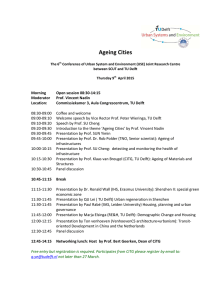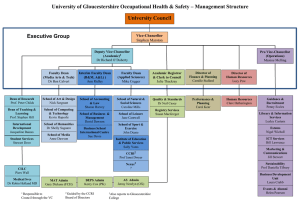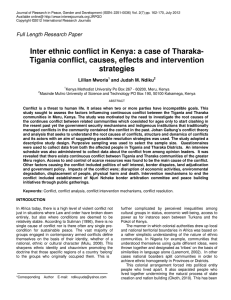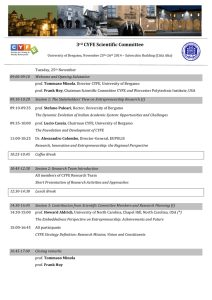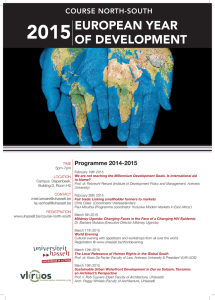Tharaka/Nithi County Strategic Plan PPT
advertisement
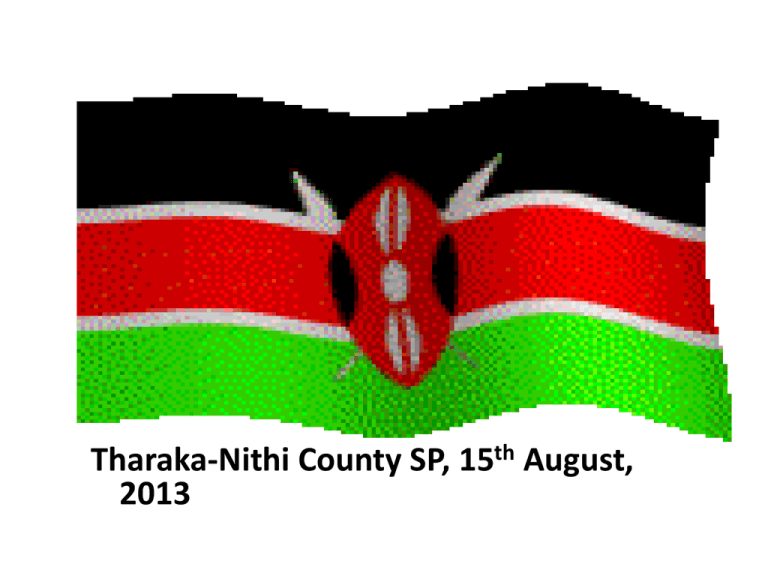
Tharaka-Nithi County SP, 15th August, 2013 A Presentation of Meru Professionals Association (MPA) Draft 2012-2017 Tharaka-Nithi Strategic Plan 1. Introduction: Prof. Njoka – VC Chuka University and Chairman, MPA 2. The Draft 2012-2017 Tharaka-Nithi SP: Prof. Micheni 3. Next Steps – Dr. Mbaabu – Chair; Strategic Planning Sub-Committee Foundations of Strategic Planning “All this” David said, “I have in writing from the hand of the Lord upon me, and he gave me understanding in all the details of the plan.” 1st chronicles 28:19 “The dogmas of the quiet past will not work in the turbulent future. As our cause is new, so must we think and act a new” (Abraham Lincoln) Prof. Jotham Micheni Why Strategic Planning? The rationale for strategic planning and management is that an agency requires a clear strategic direction to achieve its objectives. This is summed up in the maxim that, “If you do not know where you are going, any road will take you there”. Prof. Jotham Micheni Governor and County Government SP To the people of Tharaka Nithi County; • A Solution to immediate, medium, long-term needs • An Umbrella – brings all the people on board • A Symbol - conferring identity and dignity • A Development soloist – calls the tune and ignites! Development of Tharaka Nithi: Our song, Our dance Tharaka-Nithi County Priorities/CSF Immediate, Medium, and Long term measures to ensure: • Wealth Creation, Economic Development • Food security • Social Cohesion, security • Education, skills development, Innovation • Creating Jobs • Health • Shelter Ameru Professionals Association (Two Counties; One People) • Academicians; Politicians, Entrepreneurs, Cultural Leaders, Faith Based Leaders, Public Service leaders, • Strong Belief in Capacity of Tharaka-Nithi County leadership and people • Commitment to support. • Home has highest sentimental value • Aggregate of individuals actions; big impact Ameru Professionals: Friends of the Ameru Counties • Use of own resources in support of development in the two counties • Works only within constitutional process of participation • Able Chairs: Prof Kaimenyi, Prof. Njoka • Chairman SP Committee – Dr. Mbaabu Mathiu (Peace Mediator, Environmental Governance) MPA Executive Committee Chairman: Prof. Njoka Vice Chair: Prof Naituli Treasurer: Dr Mary Mwiandi Secretary: Mr Henry Kurauka Members – Prof Micheni (Chuka), Prof Kithaka (Tharaka), Prof marangu (Maara), among others…… Consultations for Strategic Plans • November 28th 2009 Chuka meeting resolutions, • March 13th 2010 Thiiri centre meeting and • October 2nd 2010 Marimanti meeting, • October 8th 2011 Maua meeting on education • Chuka University College on 3rd March 2012 • MPA executive meeting of 26th May 2012 at Jacaranda Hotel in Nairobi to finalize Professionals Teams 1. 2. 3. 4. 5. 6. 7. 8. 9. 10. Draw a strategic plan for each county Craft Criteria for Quality Leadership. Making the counties competitive and attractive to investors. Making Ameru people economically empowered Making Ameru people empowered through education Investment in electronic and mass media Transforming Ameru through ICT Health Tourism, New Crops, animal breads and fisheries Arts, Culture and publishing Concept of inclusivity Chairperson to co-opt additional members • Extensive Consultations • Chairpersons co-opted additional members • to make informed choices. Papers Submitted, Reviews and Drafting of Strategic Plan • Papers were received from all the Professional teams as above • Reviews and Comments; Prof Kithaka Wa Mbeeria, Prof. E. Irandu, Prof. Jacob T. Kaimenyi, Prof. Njoka, Mr. Gitonga Mutungi, Mrs. Charity Koronya, Prof Margaret Kobia, Mr Silas Kobia and Mr David K. M’Mugambi. • SP Methodology and Facilitation: Dr. Mbaabu Mathiu and Mr. David K. M’Mugambi Tharaka Nithi County Strategic Plan (Principles; page 6) • Extensive consultations with key and representative stakeholders. • Gender equity and representation of all, including marginalized and special needs groups. • Collaboration among County government, businesses and civil society to sustain economic progress. • Balance between economic progress and quality of life. • Protection and support for existing businesses. • Development of employment using internal resources as opposed to external factors. • Encouragement of creativity and innovation through incubation of ideas with potential. • The private sector is the main generator of economic development in the county. MPA Chairs County Governments Primary Responsibility • Economic Development (Creating plenty from little - wealth for many) • Social Cohesion (A people at peace with themselves) • Service Delivery and creating confidence in Government (Leadership and people) Economy: Determinants of Productivity Growth (Business Environment) • • • • • Skills, Talent Institutions Regulations Public Sector, Tax Macros, National Gov, Regional, Africa Economy: Determinants of Productivity Growth (Firm, Market Performance) • Ideas, Innovation, entrepreneurship • Savings, Investments, Financials, Markets • Linkages, Groups, philanthropy, Diaspora Social Cohesion • • • • Change Governance Leadership Participation Kenya Vision 2030 & Devolution Quality of life through 3 pillars • Economy • Social • Political At the County Quality of life is achieved through • Economy • Social Cohesion • Service Delivery Agriculture and the Environment Photo by Felix Masi “Agriculture is a mainstay of the Kenyan economy and currently represents 24 per cent of GDP. ” V2030 22 Agricultur • Better Agriculture More profits, Facilitates self reliant • Modernize • Fertilize for higher yields • Improve income • Reduce environmental degradation Photo by The World Bank • Progress on Vision 2030 23 Tharaka-Nithi County Strategic Plan (Justification) The Strategic Plan will provide • viable future direction of development services • resource mobilization, allocation and use, • monitoring and evaluation of progress. The plan process aims at providing a clear • appreciation of the County environment • determination of its strategic niche • process of focused strategies aimed at guiding thoughts and shaping actions. (See pg 7) Proposed Vision A county of choice for investment where residents enjoy the highest quality of life under a visionary and democratic leadership. (see pg 8) Proposed Mission Statement • transform Tharaka-Nithi County into a high income county • achieve high quality of life and secure environment, • strengthen unity of Professionals, Leaders and Citizens • chart a united response to the challenges of development • ensure provision of quality services Values • • • • • Quality and Responsive leadership Inclusiveness, Equity and Equality Professionalism and integrity Transparency and accountability Creativity, Innovativeness and Competitiveness • United and Responsible citizenship • Hospitable Customer Care and Respect for Human Rights • Respect for and conservation of environment Core Business Provide a process for individuals and groups to • Support Tharaka Nithi County Government to accelerate “The Great Ameru Transformation” • Secure increased returns for investors • Achieve the highest quality of life for people living, visiting or working in Tharaka Nithi County. SWOT Analysis • Tharaka-Nithi is endowed with a hard working people • Tradition of mutual social support • Diminishing returns from traditional means of livelihood. • Harnessing the community strengths and turning weaknesses into opportunities for improvement • New dispensation, only strong and courageous leaders will make an impact Strategic Analysis Core Strategic Issue To create a competitive and prosperous county with a high quality of life for the Tharaka-Nithi community and Kenya at large Address “Weak and unsustainable socio-economic and political development of Tharaka Nithi County and strengthening of unity among leaders for the wellbeing of Tharaka-Nithi Citizens”. Objective 1: To Improve Governance and Leadership To promote values and issue-based, accountable leadership that is responsive to the Tharaka Nithi County aspirations in social, economic and political spheres. (Wanted: leaders of integrity of heart and skillful hands. ) • 9 Strategies proposed. (See pg 20) • Form: Joint County Leaders Forums Strategic Objective 2: To Grow the County Economy To enhance management and development of the physical environment, optimizing the use of available community resources to support stable economic performance of over 10% GDP. The aim of economic pillar is to build Tharaka Nithi County as an industrial and investment hub that is competitive and attractive to investors and industrialists while empowering the local people to take the first economic opportunities. Strategic Objective 3.3 To invest in people: The Social Sector To enhance the benefits to the people accruing from successful social programmes such as promotion of Ameru culture and TharakaNithi identity, education, health and creating a harmonious society (Education, Health, Culture, Arts and Sports, Housing and Urbanization, Communication, special groups, gender,) (see pg 24) Strategic Objective 4: Resources Mobilization To explore ways and means of growing the Central Government grants to finance an ambitious “Transformative” development programme envisaged in this strategic plan. (Detailed resource mobilization strategies required) Taxation Development funds Vs Recurrent expenses Strategic Objective 5: Capacity Building for Organization Development To support institutional capacity building of Tharaka Nithi County in: • Start up activities by providing professional and technical support such as community resource mapping and development of plans. • Strategies for recruitment • Strategies for service improvement (One-stop-shop?) • Relations with NG in the County • Training, Coordination issues Diminishing Returns WAY FORWARD • Proposed resolution • That the Draft 2012-2017 Tharaka-Nithi Strategic Plan Framework developed by the Meru Professionals Association • Is adopted as reference document in the County Integrated Development Planning Process. Draft Strategic Plan • A living document to enrich County development planning process • Needs experts to guide the County Integrated Development Plan (CIDP) planning process • All leaders to be involved • CIDP is required as tool to unlock the County potential • CIDP is also a statutory requirement Strategic Plan Framework Vs County Integrated Development Plan • Businesses have Strategic Plans • Counties have Integrated Development Plans • The Purpose is similar: To Start and Sustain Development • CIDP is a Strategic Development Plan County Integrated Development Plan (CIDP) Participatory Process to integrate: • Social, political, Institutional, Fiscal • Economic, Sectoral production areas, • Environmental, • Physical • Spatial dimensions In development planning Purpose Resources used optimally for sustainability and viable service delivery CIDP: Statutory Requirement Supportive Authorities • Constitution of Kenya 2010 • County Government Act, 2012; • Urban Areas and Cities Act, 2011; • Public Finance Management Act, 2012. • National Land Policy • National Government Policies Next Steps - 1 Plan for the following: • Social Development • Economic Development • Environment use and sustainability • Physical planning, like land adjudication • Spatial planning – future settlements, economic hubs (Define these in respect of Tharaka Nithi and enrich the draft strategic plan) Next Steps - 2 • Hold County Validation Conference (Already taking place today?) • Form Steering Committees • Collate ideas • Develop first draft of CIDP • Submit for County Governor’s approval • Send to Sub-County Forums • Ensure Ward Priorities are captured Next Steps - 3 • Receive agreed on Sub-County, Urban and Ward priorities • Collate Priories to remove overlaps • Develop Final draft CIDP • Develop Draft 2013-2014 Tharaka - Nithi County Annual Work Plan • Develop Draft 2013-2014 Sub-County, Urban and Ward Plans • County Governor approves all the plans. Next Steps - 4 • CG Submits to stakeholders for validation • 1 Meeting per Sub-County or 1 County Conference with representatives • 1 County meeting with selected stakeholder representation. • CG Submits final draft to County Assembly • CG Submits Approved CIDP to relevant agencies • CG Directs Implementation by departments through County Executive Immediate Steps Need to agree on: • Strategic Analysis • Vision, Mission • Broad Issues of concern and proposals • Strategic objectives and Strategies • Plan of Action with timelines (of the planning process) Transformation of Tharaka-Nithi County is Possible; NOW
